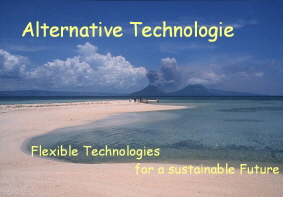|
How to clean water? Water Purification Technologies
Starting with some simple and cheap technologies.
Solar water disinfection, Sodis
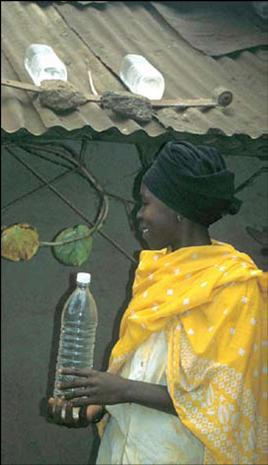
Water is placed in transparent plastic PET bottles, which is first oxygenated by shaking partially-filled capped bottles prior to filling the bottles all
the way. The completely water-filled and capped bottles are exposed to sunlight, preferably on a corrugated metal roof, slanted slightly to maximize
the exposure to solar radiation. For six hours in full sun, or for two days in partial sunlight.
Microbes are destroyed by temperature and UVA radiation provided by the sun. The combination of the two effects (UVA and heat) provides a
simple method of disinfection for use in tropical countries.
The use of glass bottles may or may not provide the same effect (thicker etc).
The researchers gave 206 Masai children clear, 1.5-liter plastic bottles. The children in the test group were told to fill the bottles (from the
contaminated water supply) and place them on the roof, from dawn to midday. The control group kept their bottles inside. Diarrhea incidence in the
two groups was tracked over 12 weeks. The researchers found that this solar radiation method may significantly reduce diarrheal disease for communities that have no other way to disinfect water.
More on www.sodis.ch

Heating or boiling
Boiling water will kill bacteria as well as other disease-causing microorganisms like Giardia lamblia and Cryptosporidium parvum which are commonly
found in rivers and lakes. Water temperatures above 70 °C (158 °F) will kill all pathogens within 30 minutes, above 85 °C (185 °F) within a few
minutes, and at boiling point (100 °C (212 °F)), most pathogens will be killed.
Boiling cannot remove chemicals, nor heavy metal contamination, e.g., colloidal metal pollutants
To improve quality: Pre-filtering by a fine meshed cloth, let the water settle before;
Let the water sit for a few hours after boiling in a vessel, the water picks up air and loses its bland taste. Improve the taste by flavoring plant
materials adding during boiling. If done properly, boiling is a very effective and simple disinfection method, but requires a significant amount of energy, if not used the sun directly.
A combination of heating plus filtering with activated charcoal can neutralize most pathogens and pollutants.
This process can be realized by a Solar-cooker.
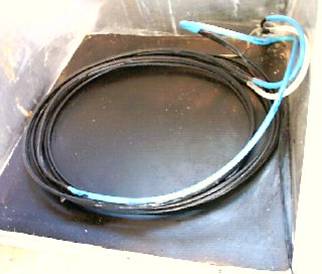
How does the cleaning of water works?
In the free space of a Solar-Cooker you put a plastic or copper-pipe; Through this the water will be heated. After this it will pass a simple heat
-exchanger (reverse-flow-principle) for to use the energy of the hot water to preheat the incoming cold water. Through this you will have a very
good yield for the water-pasteurization-process. But you can Bypass this to get the hot water for tea etc.
The transport of the water works through a small pump, for example a old pump of a car for to clean the wind-screen. In this way you have the water
directly where you need it for example in the kitchen. The Heat-exchanger can be delivered by Alternative Technology, if necessary also other
components. But isn’t it more interesting doing the things by yourself? You find more on:
www.alternative-technology.de/Solar-Cooker/solar-cooker.html
UV-Light Treatment
Uses UV-C light in the short wavelength range of 100–280 nm prevents microbes from reproducing. Without reproduction, the microbes become far
less dangerous.
Water turbidity must be low! Thin water films are necessary! Many substances inhibit the transmission of the light. The water must be pre-filtered.
some severe disadvantages! The UV lamp requires replacement annually; No Standards-Lamps, expensive!. Eliminate waterborne pathogens (germs, viruses, and molds)
UV disinfection does not kill giardia or have a residual effect on bacteria that may be reintroduced into the water after UV treatment.
Problem: Bacteria which hide behind pollution. Filter before to improve that
UV-treated water must therefore not be exposed to visible light before consumption to avoid ingesting reactivated and dangerous microbes.
It is the viruses that is the limiting factor of UV treatment.
The proposed technology uses ultraviolet (UV) light to from the local water supply.
Consuming a total of 40 watts, the system disinfects approximately 30 liters of water per minute;
The estimated one-time capital cost of an ultraviolet system is $500, including valve, fittings, and labor. the UV lamp requires replacement annually.
Bacteria and viruses often accumulate bigger particles!
Lamp must be pre-glowed.
upflow filteration
at low filtration-rates and sufficient oxygen content of raw-water, biological activity can be observed; reduction of 50 - 70 % of organic and
inorganic coarse and fine particles
Filter-medium: coarse sand 3-4 mm; cleaning of the filter, 5-10 min every day, to prevent the filter-bed of
clogging; better results: decreasing grain-size to top;
Activated charcoal
can remove many pollutants, without removing pathogens. Reduces chemicals, has better taste.
If not used can be a breeding ground for bacteria. No visible indication of when needs to be replaced.
Remove the very first water of a new candle. There can be a critical concentration of charcoal dust.
With Silber-Ions: There is a concentration which could be dangerous
Can also remove Pesticide-agent and their Metabolite or Medical remains
Ceramic-filters
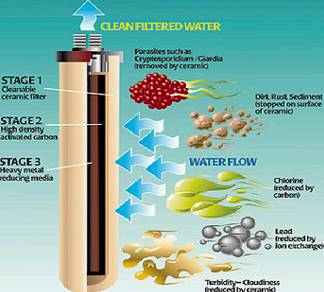
Removing pathogens down to the 0.2–0.3 micrometer (µm) range, reduces Baterieas and Protozoen;
If the water is not too turbid (may clog the pores)
If the pore-size smaller than 1.5 um, the pathogens get removed also;
Filter with bigger pores remove only microorganisms as cysts and worm eggs are removed
strands of thread-like Leptospira spp. bacteria, (that can cause leptospirosis), are thin enough to pass through a 0.2 micrometer filter
Afterwards.cleaning: brushing under running water, boiling the candle; low filtration without pressure!
The elements themselves can become colonization sites. In recent years some filters have been enhanced by bonding silver metal nanoparticles to the ceramic element and/or to the activated charcoal to suppress growth of pathogens.
Ceramic filters filter 5,000 to 50,000 liters per cartridge
clay-filters with silver
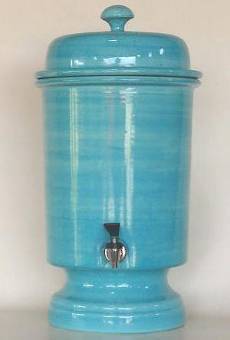
excellent results! also removal of bacteria; 2,14 l/day; 1 year longlivity; 55-65% loam, 30-35% crushed feldspar or 20-40 % sand, 5-10% sawdust, 3,2% colloid silver; Guatemala 7,70$; Silver verhindert weiteres Wachstum; auch in Britta-Filter drin
slow sand filtration
also anti-bacterial (Schmutzdecke), but slow flow, sufficient oxygen in the raw water, steady temperature.
constant flow is necessary!
Deep tubewells
Because the wells are more than 200 feet deep, the water has been sealed beneath an impermeable layer of earth for a long time and is commonly
bacteria-free. One disadvantage of obtaining water from a deep tubewell is that many people dislike the taste. Because the water is old, it has a high
dissolved salt content, and many people prefer the taste of fresher, surface water. Additionally, deep tubewells can be expensive and time
-consuming to construct because of the specialized deep-drilling equipment that is required.
Chemical treatment
chlorine (best and most tested but not easy to get and store this chemicals), iodine, bromine, ozone;
Chlorine disinfection
kills all pathogens, including giardia. In addition, chlorine has a residual effect; that is, if bacteria are reintroduced into a chlorinated water supply,
the new bacteria will die. Although chlorine disinfection is a well-proven technique, it has a few disadvantages. Often, people dislike the taste and
smell of chlorinated water. In addition, because it is easy to overdose water with chlorine, it is necessary for a trained person to test chlorine levels before water is consumed.
Silver+Chlorine: 20-35min contact;
Ozone-treatment
Ozone makes oxidation of solved organic elements and removes bacteria, viruses and germs. With the Aeration, one saturates waters with air. You
combine with air water in a manner that there is maximum of contact. By this procedure, you remove smell and bad taste and expels transient gases f
.e.. Chlorine. Furthermore, iron and manganese-Solutions are transferred in insoluble oxide-hydrates. These can be removed afterwards by filtration.
Reverse-Osmosis
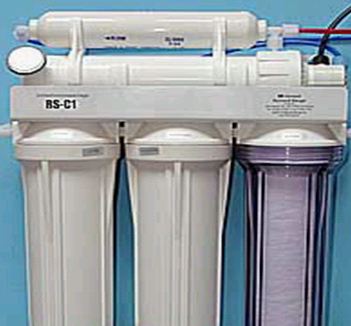
Removes all suspended particles, filters all ionized or adequately big-molecular materials from the water, also all minerals and trace elements.
Removes almost everything; but water can be remineralised after treatment. Or add 10% of untreated Water to it.
The pH gets to about. 5,5.
A disadvantage is the large volume of unused waste water. But can be used for toilette, garden etc.
For the desalinating of sea water, the reversal-osmosis is more advantageous than the more expensive energy-intensive distillation. Reversal-osmosis is applied in the industry or in laboratories in order to produce chemically (almost) pure H2O.
The cost drop to 100-1000 Euro. The filter must be changed about every year. The costs are about 20 $. The membrane must be changed about all 3
years, but depends on the quantity of water to be produced.
Links: Here a good supplier
More Technologies
LifeSaver bottle
, filters with a combination of hand pump, filter membranes and a charcoal filter. This new system removes particles larger than 15 nm, and thus is able to filter-out viruses. More on
http://www.lifesaversystems.com/techinfo.html
The LifeStraw
removes particles larger than 15 microns with a set of two membrane filters and a carbon filter. The polymer membrane filters are
impregnated with antimicrobial halogens to kill pathogens, and the carbon filter is impregnated with silver to inactivate residual halogens from the membrane filters. More on
http://www.vestergaard-frandsen.com/lifestraw-specifications.htm
EM-Ceramic-Filter
Combination out of activated carbon and effective microorganisms
This is suitable for the production of cleaned and biologically active drinking water
Aeration
remove unpleasant taste and odors and colour
2-4 weeks storage
can reduce bacteria from 50-90 %
Homemade water filters
using local materials such as grass, charcoal (e.g. from burned firewood), and sand
simple cleaning System: waterpps: Solar (2*52Wp, 42Ah Vlies-batterie) und Keramikmikrofilter
Links and more Documents
Water treatment and technical design
Analysis of water
Storage of water
A lot is stolen from the wonderful Wikipedia so go there for further information like:
http://en.wikipedia.org/wiki/Portable_water_purification
www.flowthefilm.com/takeaction
www.sodis.ch
www.waterquality.de
www.watercone.com
www.intaqua.com
http://www.waterfootprint.org/?page=files/home
www.fogquest.org
UNRIC – Water: http://www.unric.org/index.php
?option=com_content&task=category§ionid=5&id=129&Itemid=155
http://www.lifesaversystems.com/techinfo.html
http://www.vestergaard-frandsen.com/lifestraw/lifestraw
Here is the Updated document for Download
You can also contact me for more detailled information; click here
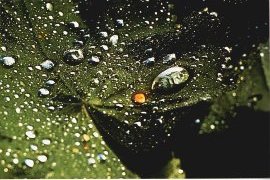
Water, what a wonderful and precious resource!
more
|
